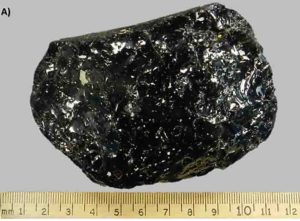
It was a stroke of serendipity that led to Michael Zanetti’s discovery of the hottest rock on Earth.
In 2011, Zanetti, now a postdoctoral researcher in Earth Sciences at Western, was on an analog mission with Earth Sciences professor Gordon Osinski at 28-kilometre-wide Mistastin Lake crater in Labrador – a Canadian Space Agency (CSA)-funded endeavour using the impact structure as a test bed for exploration strategies and field equipment for use on the moon and Mars.
A PhD student at Washington University in St. Louis at the time, Zanetti’s eye honed in on something that stood out within the crater.
“My role was basically to assist the mock astronauts and take notes. Being a wide-eyed graduate student, I kept my eyes open for interesting rocks and things like that,” he said.
“Being an impact crater guy and being in one, I was super excited. When I was out there, I found a rock that didn’t look in place. It was essentially glass – which, in geotechnical terms, is a rock – that didn’t have any crystals in it. It melted. Before it had a chance to form any little crystals in it – which form slowly as things cool – it cooled rapidly and quenched a glass,” he explained.
When a city-sized asteroid hits the ground at 15 km/second, an enormous amount of energy is released, like “a billion hydrogen bombs worth of energy,” Zanetti said.
This produces a lot of heat – so much heat, you could vaporize rocks. The rapid cooling that follows impact ‘freezes’ in place whatever is inside the rock. In the case of the glass rock that caught Zanetti’s eye, small zircon grains from the host rocks were frozen in place.
Zircon – a mineral known by many as a cheap diamond substitute – doesn’t break easily and doesn’t melt, even at temperatures hot enough to melt surrounding rocks. Instead, the zircon grains present in host rocks recorded the heat at the time of the asteroid’s impact 38 million years ago.
The rock Zanetti found recorded the hottest temperature in a rock formation on Earth as a result of the asteroid impact – a whopping 2,370 C.
“The big picture here is this – very hot temperature is at the centre of the Earth; it is unusual here. There are hot temperatures and high pressures down deep in the Earth but not at the surface of the Earth,” Zanetti said.
“You’ve got these little zircons floating around (in this rock). They’re feeling the effects of this heat and one of the effects of this very high heat on zircon is to change its crystal structure to cubic zirconia. This little zircon inside this little sample I found records that; it got frozen in place by quenching to glass halfway through. If it had gone on another couple of seconds, the heat might have just completely engulfed this grain. But this is just kind of a rare happenstance that it got frozen halfway completed.”
An analysis of the rock, and this record-breaking temperature, led by Nicholas Timms at Curtin University in Perth, Australia, co-authored by Zanetti and colleagues in Switzerland and the United States, was recently published in the journal Earth and Planetary Science Letters.
The crux of the science behind this discovery is that it closes the gap between computer models, Zanetti explained.
“We can do the math on what happens, and how much energy is really released when a giant asteroid hits the ground really fast, and we can get estimates on what these temperatures should be, and where in the crater these temperatures should be found. But what we have now is an actual hand specimen that we can say, ‘This came from this place and it got this hot,” he said.
The entire reason this rock was found was because of a Western-led CSA-funded expedition for something completely unrelated, Zanetti stressed.
“I didn’t set out to find a hot rock. The other part of this is how lucky things can get. One, I was lucky to get on that mission, lucky to get this rare sample, lucky when I cut into it that I cut across one of these rare zircons, lucky that I was with a team of people who could identify it for what it was and lucky to find the right people to analyze it,” he noted.
“Sometimes it takes just a bit of happenstance to find some cool things.”
Reference:
Nicholas E. Timms et al. Cubic zirconia in >2370 °C impact melt records Earth’s hottest crust, Earth and Planetary Science Letters (2017). DOI: 10.1016/j.epsl.2017.08.012
Note: The above post is reprinted from materials provided by University of Western Ontario.










